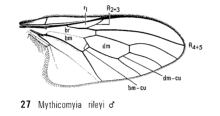
Wing of female of Empidideicus humeralis, modified from Fig. 45.26 on pg. 594 of McAlpine (1981) Key to Families - Adults,
, Ottawa, p.89-124, (1981)
[1].
Additional wing vein labels and descriptions of the abbreviations contributed by Aaron Schusteff:
Veins ("traditional names" from older literature in parentheses):
C = costa...running along the forward margin of the wing
R1 = 1st branch of the radial vein ("first longitudinal vein")
R4+5 = branch formed from fusion of the 4th and 5th branches of the radial vein ("third longitudinal vein"). Note: the "2nd longitudinal vein", R2+3, is absent in Empidideicus)
M = portion of media proximal to branching point
M1 = 1st branch of the media (1st branch of "fourth longitudinal vein")
M2 = 2nd branch of the media (2nd branch of "fourth longitudinal vein")
CuA1 = 1st anterior branch of the cubitus (1st anterior branch of the "fifth longitudinal; vein")
CuA2= 2nd anterior branch of the cubitus (2nd anterior branch of the "fifth longitudinal; vein")
A1 = 1st anal vein
Cells:
br = basal radial cell (or "1st basal cell")
bm = basal medial cell (or "2nd basal cell")
Additional Remarks: Formerly treated as a member of Bombyliidae, Melander and Hull noted that Empidideicus has the most reduced venation of within that group...in particular, having the 'second longitudinal vein'(= R2+3) and discal cell absent.
- Log in to post comments
- Log in to post comments





